Gold is no longer a contrarian bet.
It features regularly in the money sections of newspapers. There are ‘we buy your gold’ shops everywhere. And more and more funds and financial services companies are setting up to cash in on the boom.
It’s not a bubble either. It’s still held in contempt by the economic ‘elite’. Apart from the odd dissenting voice buried in the back pages, you’ll rarely find a pro-gold story in the FT or The Economist, for example.
But gold’s appeal has certainly been rediscovered by the wider investing public. And it’s little wonder why. Because those ever-so-clever central bankers screwed up badly.
The Best Way to Think of Gold
I find that the best way to think of gold is as a currency.
Gold has been used as money throughout history. That’s because it’s well suited to being money.
It’s durable – you don’t have to worry about it rotting or rusting, so you can hold on to it if you don’t want to spend it right away.
It’s fungible – one bit of gold of a given quantity is just like another. And it’s portable, within reason.
Indeed, gold had an official role in the monetary system right up until 1971, when Richard Nixon severed the link between gold and the US dollar.
What’s special about gold is that it’s a currency that no one can print. You have to dig it out of the ground. It also can’t go bust. History is littered with paper currencies that are literally worthless. Gold’s value has never fallen to zero.
So at a time when central banks are printing money like mad, with no clear idea of what impact it might have, it makes sense that demand for gold increases. Because, to put it simply, the amount of paper money in the world is going up a lot faster than the amount of ‘real money’ – gold.
That’s the case for owning it, and I think it’s a sensible one. But how much of it should you own?
Gold as Insurance
I like gold. But after 11 years of constant increases, I believe we’re nearer to the end of the gold bull market than to the start. This is the stage where more and more people are going to start piling in for the wrong reason. They’ll buy gold because it’s going up, not because it’s a sensible investment.
That means that this is also the stage where – even though there are likely higher peaks ahead of us – some people are going to start getting badly burnt in the inevitable panic sell-offs.
So it’s important to get your rationale for buying gold right. It’s not 2001 anymore. You can’t just buy it and sit on it, safe in the knowledge that chances are, it will never ever be that cheap again, and that you’ll always be able to sell at a profit.
And if you’re hoping to ‘ride the bubble’ when it comes, put that thought out of your head right now. That way, financial disaster lies. Timing a bull or bear market is painful. No one can know when the final peak or trough will come.
So what do you do?
Well, another way to think of gold is as an insurance policy. You don’t put your entire portfolio in gold. It’s something that you hold to insure the rest of your portfolio against financial disaster.
The possibility of such a disaster seems quite high just now, which is why the insurance policy (gold) is more expensive than it once was.
So we’d suggest that you invest 5-10% of your portfolio in some form of physical gold (gold stocks are separate – they’re driven by more than just the gold price, and they’re certainly not insurance).
And when you check your portfolio every six months or so, you rebalance accordingly – if gold’s share of your portfolio is creeping higher, sell some and invest in something else. If it’s dipping, then top it up.
That way, you’ll profit from the inevitable ‘bubble’ phase. But you won’t be left over-exposed when prices go down, as they one day will.
And when the gold bull-run is over, you’ll be pleased. Because when the gold price re-enters a bear market, it’ll be because the wider economy is finally turning around. And you’ll be able to buy cheap insurance again for the next crisis.
John Stepek
Contributing Editor, Money Morning
Publisher’s Note: This article originally appeared in MoneyWeek
From the Archives…
Beer and Tax in Retirement
5-10-2012 – Nick Hubble
Possibly the Most Important Thing You Will Ever Read in Money Morning
4-10-2012 – Nick Hubble
What Central Bank Money Printing Means for Small-Cap Stocks
3-10-2012 – Kris Sayce
This is What a Million Dollars of Liquid Gold Looks Like
2-10-2012 – Dr. Alex Cowie
Japan’s Energy Crisis and the Take Away for Aussie Investors
1-10-2012 – Dan Denning












